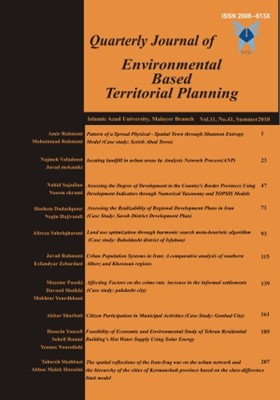The spatial reflections of the Iran-Iraq war on the urban network and the hierarchy of the cities of Kermanshah province based on the class-difference limit model
Subject Areas :
tahereh shahbazi
1
,
Abbas Malek Hosseini
2
1 - i, Ph.D. Candidate of Geography and Urban Planning, Islamic Azad University, Malayer Branch
2 - Associate Professor of Geography and Urban Planning, Islamic Azad University, Malayer Branch
Received: 2017-07-26
Accepted : 2018-06-10
Published : 2018-08-23
Keywords:
Kermanshah province,
Iran-Iraq War,
class-difference limit model,
Abstract :
in recent years, for many reasons populated urban centers of Iran with severe spatial changes that resulted in the increase in small and medium urban imbalance in the hierarchy of the country were observed. This study examined the hierarchy of urban developments to those in the cities of Kermanshah province during the 1976 to the 2016 war time on the urban network hierarchical province .The method of the present research was quantitative - analysis in which models of deferential class analysis, prime city index, the rank - size, ranking model modification have been used. The results showed that the distribution pattern of urban settlements in Kermanshah province was unbalanced during war which imposed imbalances to all the difference parts. It was found that Kermanshah city due to the performance of various factors have had a strong performance, and had attracted surrounding populations from other provinces, especially in times of war as a city which was predominant caused uneven systems in the city. Therefore, in order to maintain the last balance, a phase of reallocation and redirection of functions to the neighboring cities is recommended.
References:
احمدی، ح. چهاردولی، ح. 1376. سلسله مراتب شهری تهران، مرکز مطالعات برنامه ریزی وزارت کشور.
امکچی، ح. 1383. شهرهای میانی و نقش آنها در چارچوب توسعه ملی تهران: مرکز مطالعات و تحقیقات شهرسازی و معماری ایران.
بهفروز، ف. 1371.تحلیلی نظری تجربی برای متعادل سازی توزیع فضایی جمعیت در سیستم شهرهای ایران تهران: انتشارات مرکز پژوهش های جغرافیایی.
پورمحمدی، م.، زالی، ن. 1386. شبیه سازی شبکه شهری مبتنی بر مدل های آنتروپی و کشش پذیری طرح تحقیقاتی، دانشگاه تبریز.
تقوایی، م. 1379.کاربرد مدل مرتبه، اندازه و ارزیابی و تعادل بخشی نظام شبکة شهری درایران، مجلة علمی- پژوهشی دانشکده ادبیات و علوم انسانی دانشگاه اصفهان، دوره دوم شماره 22 و 23.
حکمت نیا وموسوی. 1385.کاربرد مدل در جغرافیا با تامید بر برنامه ریزی شهری و ناحیه ای ،یزد انتشارات علم.
شماعی، ع. 1394. تحلیل فضایی نظام شبکه شهری استان کرمانشاه (سالهای 1375 تا 1390)، فصلنامۀ امایش محیط، شماره31.
ضمیری، م.، نسترن، م. محمدزاده تیتکانلو، ح. 1392. تحلیلی بر شکل وروند توسعه فضایی وکالبدی شعر بجنورد در دهه1380، با استفاده از آنتروپی شانون،ضریب موران وضریب گری، مجله جغرافیا، شماره33، 180-67.
لطفی،ص .1391. بررسی سلسله مراتب شهری و پدیده نخست شهری در استان کرمانشاه (در طی سال های 1355 تا 1385(فصلنامۀ امایش محیط، شماره3).
طهماسبی، ش. 1384. تکنیک ها و روش های تحلیل مسائل شهری و منطقه ای تهران: سازمان مدیریت و برنامه ریزی.
عابدین درکوش، س. 1372. درآمدی به اقتصاد شهری تهران: مرکز نشر دانشگاهی، چ دوم.
عظیمی، ن. 1382. روششناسی شبکه سکونتگاههای تهران: مرکز مطالعات و تحقیقات شهرسازی و معماری ایران.
فرهودی، ر.، زنگنه شهرکی، س.، ساعد موچشی، ر.1388. چگونگی توزیع فضایی جمعیت در نظام شهری ایران طی سال های 1335-1385. فصلنامه پژوهشهای جغرافیایی انسانی، شماره 68 ، 55-68
فنی، ز. 1382.شهرهای کوچک رویکردی دیگر در توسعه منطقه ای تهران: انتشارات سازمان شهرداری های کشور.
نظریان، ا. 1370. سیر تحولات مفاهیم و پژوهشهای ناحیه ای در جغرافیا." فصل نامة رشد آموزش جغرافیا، شمارة 20.
هاگت، پ. 1375. جغرافیای ترکیبی نو، جلد دو، م ترجمه شاپور گودرزی نژاد، تهران: انتشارات سمت.
Jefferson M. 1939.The law of the primate city", Geographical Review, 29.
Moomaw, R. M. 2004. An Empirical Analysis of Competing Explanations of Urban Primacy Evidence - from Asia and the America", The annuals of Regional Science, Vol. 38.
Pumain D. Moriconi-Ebrard F. 1997. City Size Distributions and Metropolisation, Geojournal, 43,4.
Roehner B. M.(1995);" Evolution of urban systems in the Pareto plane", Journal of
Regional Science, 35, 2.
_||_


